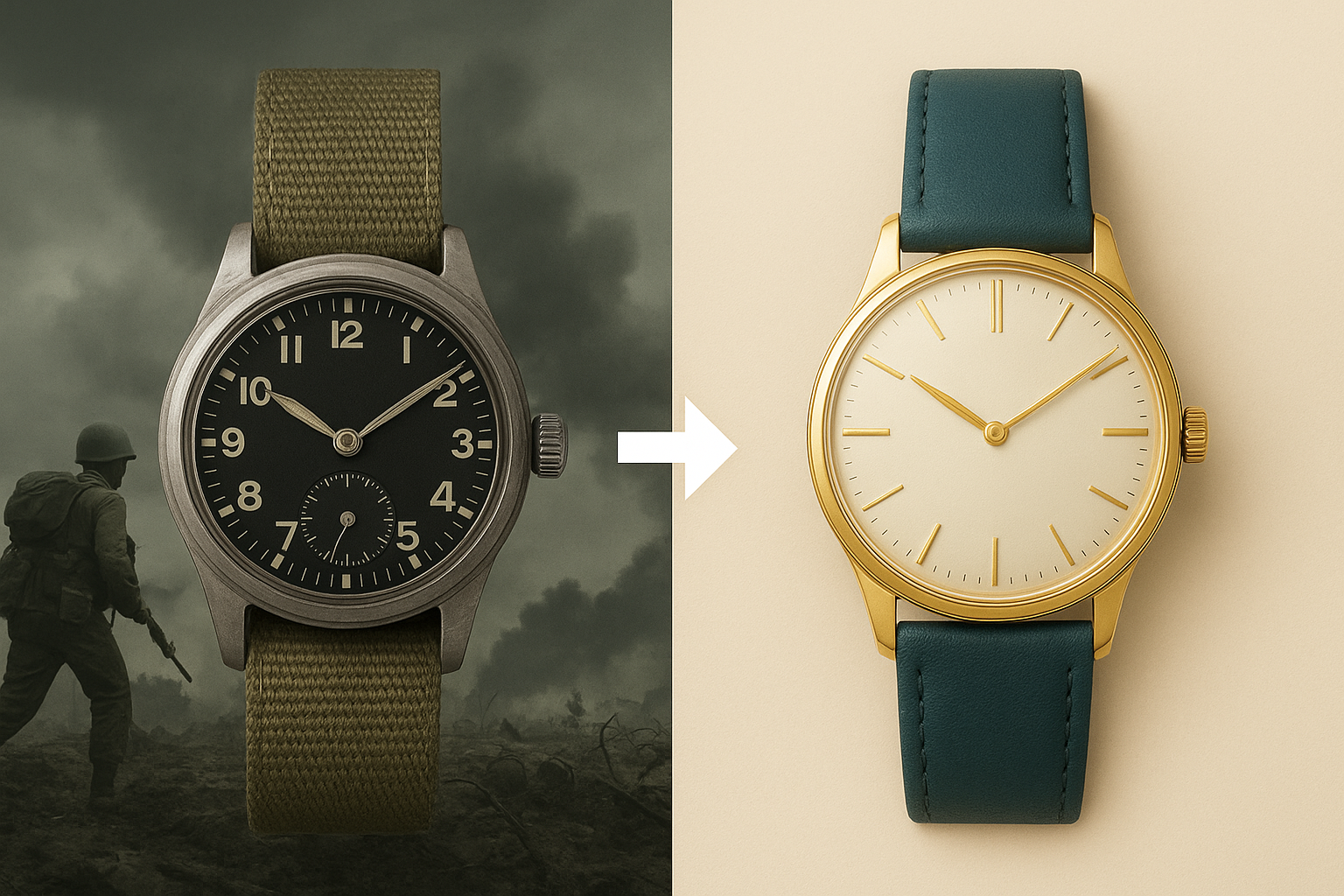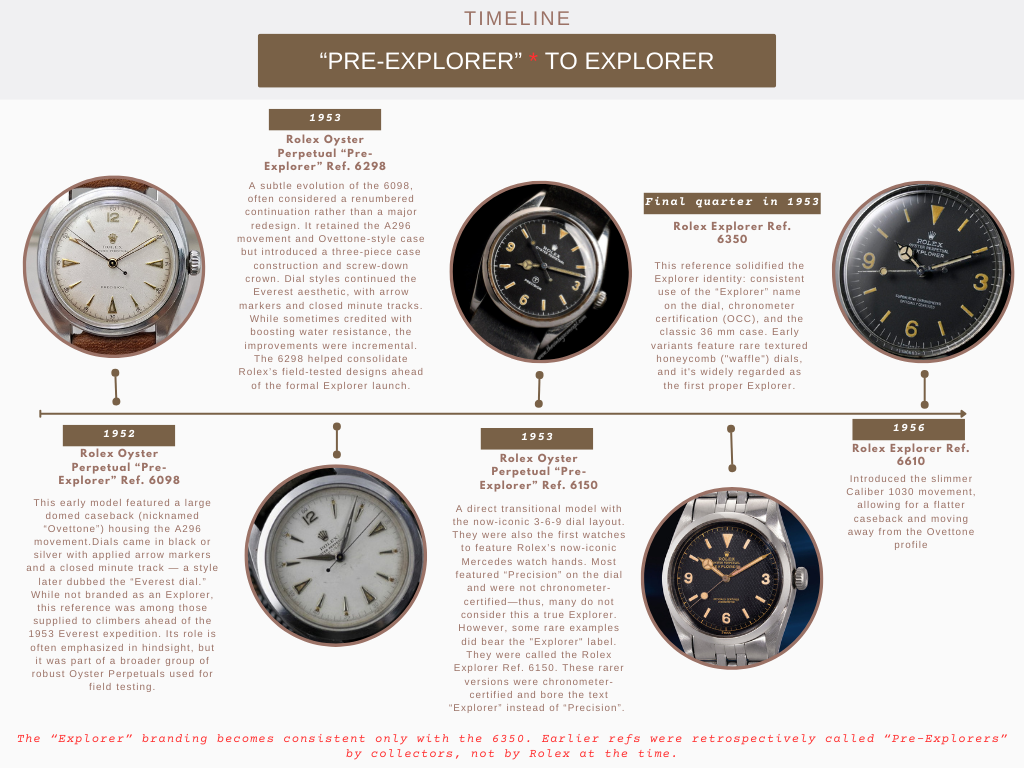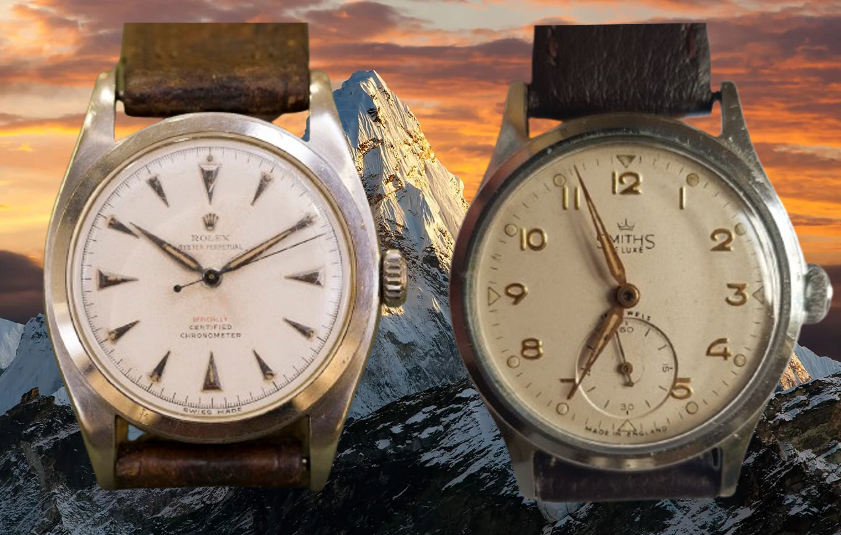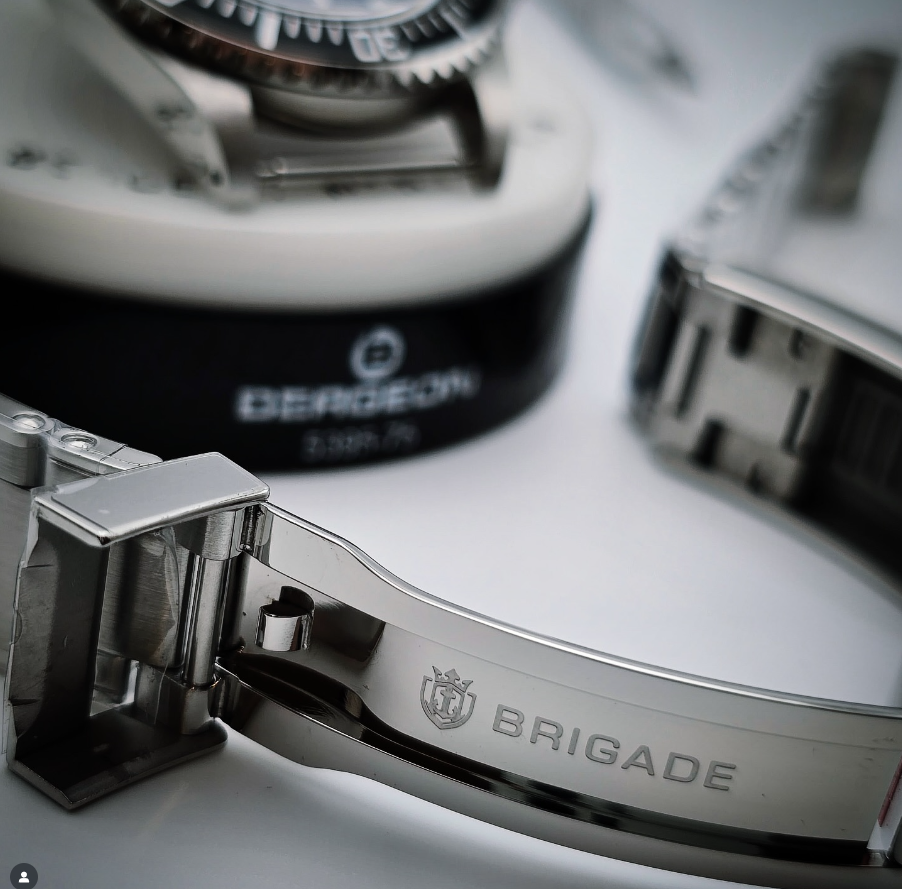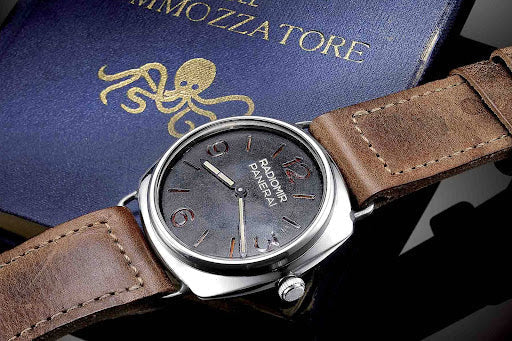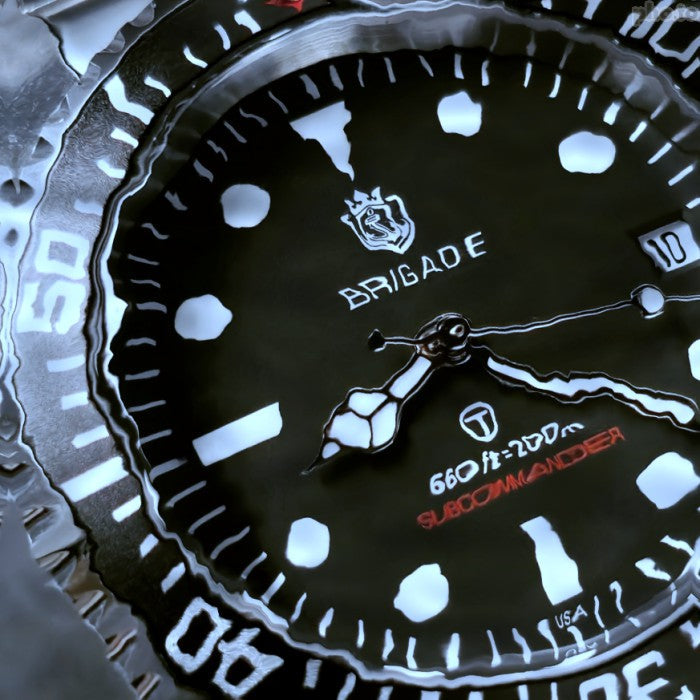November 13, 2025
The Quartz Crisis and The Mechanical Watch Transition into Luxury
In the decades that followed World War II, the traditional mechanical watches reigned supreme. Swiss watchmakers, virtually unchallenged during the war years, held more than half of the world’s watch market by the 1960s. A fine wristwatch had become more than a tool for telling time— it was a fashionable accessory that shows off who you were. Postwar prosperity saw men and women treating watches as personal style statements, whether a sleek dress watch peeking from a French cuff or a sporty chronograph on a racer’s wrist. Swiss brands like Rolex, Omega, and Patek Philippe enjoyed global prestige, and their craftsmanship and heritage were key selling points. Watches were analog, spring-driven, and built by skilled hands. In short, the 1960s watch world was all about mechanical elegance and timeless style.
Yet, even as watches became ubiquitous fashion accessories, storm clouds were gathering on the technological horizon. Unbeknownst to many Swiss traditionalists, researchers in Japan, the United States, and even within Switzerland were experimenting with a radical new way to keep time – using the vibrations of a tiny quartz crystal powered by a battery. The stage was set for a revolution that would upend the centuries-old watch industry in the coming decade.
- The Emergence of the Quartz Watch
- the Quartz Explosion
- The Swiss Watch Industry on the Brink
- Luxury Stance
- Conclusion
Table of Content
The Emergence of the Quartz Watch
On Christmas Day 1969, the Japanese firm Seiko unveiled a breakthrough that would change watchmaking forever: the Seiko Quartz Astron 35SQ, the world’s first quartz wristwatch. The Astron looked unassuming – a gold case with a simple analog dial – but inside ticked a tiny quartz crystal oscillator, humming at 8,192 Hz and powered by a battery. The result was uncanny accuracy: the Astron was accurate to within 5 seconds per month, an astonishing feat when even the best mechanical watches might drift that much in a day. Seiko boldly marketed the Astron with the slogan, “Someday, all watches will be made this way.”

The Seiko Quartz Astron (1969), the world’s first quartz wristwatch. This gold-cased limited edition was priced at ¥450,000 – about the cost of a compact car at the time
Early quartz watches were extremely expensive to produce – that first Astron cost as much as a family car– but they demonstrated the game-changing potential of electronics. Not only were they far more accurate than traditional watches, they also required no winding and fewer delicate moving parts. In the early 1970s, a race was on to refine and mass-produce this technology. Swiss manufacturers were actually close behind Seiko in developing quartz prototypes (a consortium of 20 Swiss brands had built the Beta-21 quartz movement by 1970), but the Swiss treated quartz as a high-end novelty, rolling out a few gold-cased quartz models at the 1970 Basel fair. Seiko, by contrast, pushed quartz to market and kept going, iterating on the technology rapidly. By 1973, Seiko had released the first ladies’ quartz watch, and by 1973 it had the world’s first six-digit LCD digital watch display. The quartz revolution – as it was known in Japan and the U.S. – had truly begun.

The First LCD Digital Watch: The LC V.F.A. 06LC
Image credit: Seiko Design 140 – "The world's first LCD digital watch" https://by.seiko-design.com/140th/en/topic/39.html
The Quartz Explosion
What followed in the 1970s was an industry upheaval so dramatic that it’s often called the Quartz Crisis when viewed from the Swiss perspective. Quartz watches, both analog and the new digital varieties, exploded in popularity. A key turning point came in 1972 when the American brand Hamilton introduced the world’s first digital watch, the Pulsar P1, with a red LED display. It was a futuristic stainless steel marvel – James Bond himself even wore a Pulsar in the 1973 film Live and Let Die – but it cost a steep $2,100 in gold at launch. Early digital watches were luxury gadgets for the tech-savvy elite.

The Pulsar P1
Image credit: The LED Watch – "Pulsar P-1" https://theledwatch.com/pulsar_p1_18k
That soon changed. By the mid-1970s, dozens of electronics firms (many new to watchmaking) had jumped into the market, driving rapid advances and sharp price drops. An October 1975 Business Week cover gleefully proclaimed “Digital Watches: Bringing Watchmaking Back to the U.S.,” as American semiconductor companies like Texas Instruments, National Semiconductor, and Intel churned out digital watch components. The competition was fierce. In 1974, National Semiconductor halved the price of a basic LED watch to $125, undercutting rivals. Texas Instruments went even further – by 1976 TI was selling LED digital watches for $20, and by 1977 for a shocking $10. What had been a high-tech novelty at decade’s start became a cheap commodity by decade’s end. Prices collapsed and many early digital-watch makers couldn’t survive the race to the bottom. (Hamilton, for example, sold off its Pulsar division in 1977 as the LED boom went bust.)
Meanwhile, the quality and variety of quartz timepieces kept improving. LCD displays (which showed time continuously without draining batteries) superseded the push-button LEDs by the late ’70s. Japanese companies were especially adept at both innovation and mass production. Seiko emerged as the undisputed leader of the global watch industry by 1977, producing millions of watches and pioneering everything from multi-function digital chronographs to combination analog-digital displays. Cross-town rival Citizen and up-and-comer Casio (which would launch the first G-Shock in 1983) also embraced quartz with gusto. By 1979, Japan had become the world’s top watch producer, and by 1980 Hong Kong’s factories were flooding the world with inexpensive digital watches as well. The traditional watch powers in Switzerland and the U.S. simply could not keep up with the avalanche of affordable, hyper-accurate watches pouring out of Asia.
The Swiss Watch on the Brink
For Switzerland, the 1970s were nothing short of an existential crisis. The influx of quartz watches – especially from Japan – caused a massive contraction of the Swiss watch sector. Swiss exports plummeted by the early 1980s to roughly half of their 1974 peak volume. Companies that had dominated for decades found themselves in dire straits as sales dried up. The statistics are staggering: the number of Swiss watchmakers fell from about 1,600 companies in 1970 to under 600 by the mid-1980s. Employment in the Swiss watch industry collapsed from roughly 90,000 workers in 1970 to only about 33,000 by 1984. Skilled horologists who once had guaranteed jobs for life were being laid off en masse, and storied brands either went bankrupt or were scooped up by foreign investors. In the United States, a similar culling occurred – by 1980 almost all the American watch firms (bulldozed by the quartz wave) had either closed or been sold, with only Timex and Bulova surviving in recognizable form.
Long-established brands either merged, reinvented themselves, or vanished entirely. For Swiss watchmakers, who prided themselves on precision engineering, it was a humbling moment. Mechanical movements – the beating hearts of traditional watches – were no longer the default choice for consumers. Why buy an expensive self-winding chronometer when a $20 quartz clock on your wrist kept better time? This question loomed over Switzerland’s storied maisons as they faced an existential crisis.


Notice how the dip in watch exports from Switzerland occurs after 1974. 1974 was in the midst of the era when Quartz Watches were gaining popularity.
Image credit: Tate Twinam – "Trade competition and migration: Evidence from the quartz crisis" https://www.sciencedirect.com/science/article/pii/S002219962200085X
Luxury Stance
At the same time, the high-end Swiss brands didn’t disappear – but they did pivot. As the dust settled by the late 1980s, many surviving Swiss marques like Rolex, Patek Philippe, Audemars Piguet, and Vacheron Constantin doubled down on what made them unique: exquisite mechanical craftsmanship, heritage, and luxury appeal.
Even as quartz technology triumphed in pure functionality, something interesting was happening on the cultural front. People began to reevaluate what a mechanical watch represented. If one no longer bought an expensive watch purely to tell accurate time (a $10 digital clock could do that), then why buy one at all? The answer, it turned out, was heritage, artistry, and emotional appeal. Mechanical watches, once everyday tools, were now positioned as luxury objects – celebrated for qualities beyond timekeeping.
Swiss brands discovered that a finely crafted watch could be sold as a piece of art and tradition, rather than an obsolete gadget. Advertising in the 1980s and 1990s increasingly emphasized the timeless values of Swiss watchmaking: the centuries of heritage behind a company, the painstaking work of master watchmakers, and the intangible aura of owning an object built to last generations. These watches were marketed as heirlooms and status symbols, each ticking machine a tiny sculpture of metal, patiently assembled and decorated by hand.
Rolex was a pioneer in this transformation. Throughout the 1970s and 80s, while others pivoted toward electronics, Rolex stayed largely mechanical and focused on building a reputation not just for durability, but for status. Their models – the Submariner, GMT-Master, and Day-Date – evolved from tool watches into global symbols of success. Rolex tightened distribution, raised prices, limited production, and emphasized brand scarcity. By advertising these watches as marks of professional and personal accomplishment, Rolex positioned their mechanical timepieces as milestones. They also strategically placed their products on the wrists of prominent figures, aligning the brand with aspirational lifestyles. By the end of the 80s, Rolex wasn’t just a watch brand – it was a cultural icon worn by world leaders, athletes, and celebrities. The strategy worked. Rolex watches didn’t keep better time than quartz rivals, but they told a better story: one of prestige, accomplishment, and timeless style.

Audemars Piguet took a radical design-driven approach. In 1972, the brand launched the Royal Oak, a stainless-steel sports watch with a daring industrial look. At the time, selling a steel watch for luxury prices was unheard of. But AP bet that customers would value design, craftsmanship, and exclusivity over precious materials. They reinforced this by limiting production and steadily building demand through consistent visibility in elite circles. Over time, the Royal Oak became a shorthand for mechanical innovation and stylistic boldness. It proved that luxury wasn’t defined by gold or diamonds, but by rarity, design, and cultural capital.

Patek Philippe took a more poetic route. Already renowned for making the most refined complications in horology, the brand doubled down on heirloom appeal. In 1996, it introduced the slogan that became a defining moment for watch advertising: “You never actually own a Patek Philippe. You merely look after it for the next generation.” That line reframed the watch as a vessel of legacy, positioning ownership as stewardship. The campaign ran globally with intimate visuals—fathers and sons, mothers and daughters—underscoring the emotional continuity of owning a finely crafted timepiece. Through these ads and continued excellence in movement finishing and complications, Patek solidified its identity not just as a luxury brand, but as the custodian of horological heritage.


Patek released the Nautilus in 1976 – another steel sports model designed by Gerald Genta – and marketed it with the tagline “One of the world’s costliest watches is made of steel.” That phrasing not only emphasized confidence in their pricing strategy but challenged assumptions about what luxury could look like. Vacheron Constantin launched the 222 in 1977, which laid the foundation for the Overseas line. Each brand found its own voice, but the message was consistent: the mechanical watch was no longer just about utility. It was about refinement, identity, and taste.

Jean-Claude Biver brought this philosophy to life when he resurrected Blancpain with a fierce rejection of quartz. His slogan “Since 1735, there has never been a quartz Blancpain. And there never will be,” was part manifesto, part provocation. It spoke directly to connoisseurs tired of disposable tech and hungry for permanence. Biver also reinstated artisanal practices, focused on hand-assembled complications, and limited production to reinforce exclusivity. He marketed Blancpain not as a watch, but as a philosophy rooted in patience, craftsmanship, and timeless values.

Ultimately, these strategies worked because they resonated with a deeper cultural shift. As the world accelerated into the digital age, luxury consumers began to seek objects that stood outside that rush—items that felt eternal, that carried weight, history, and care. Swiss mechanical watches, once nearly obsolete, had been reborn as vessels of emotional and cultural significance.
Conclusion: Legacy of the Crisis
In the end, the Quartz Crisis did more than disrupt an industry—it reshaped it. By stripping away the notion that a watch had to be about accuracy, it made room for watches to become objects of desire, symbols of status, and vessels of history. Swiss brands that embraced this transition not only survived but created a new standard for luxury. Today, a mechanical watch is rarely purchased for the sake of function alone. It’s an investment in beauty, story, and self-expression—a quiet rebellion against the disposability of the digital age. And it all began in the wake of a crisis that nearly silenced the tick of tradition, only for it to return stronger, prouder, and more precious than ever.

